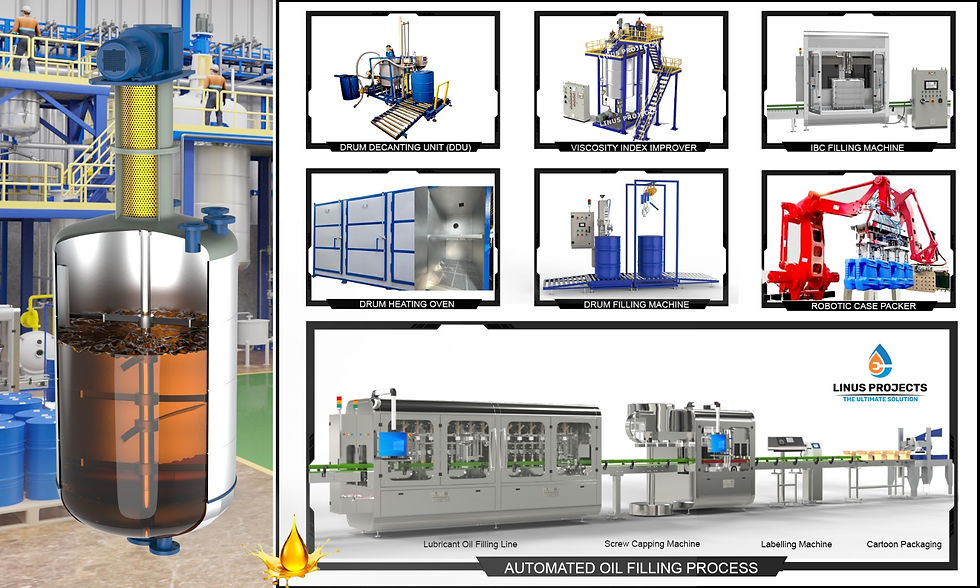How to Avoid Contamination in Lube Oil Blending Plant
- LINUS PROJECTS

- Apr 18
- 4 min read
Updated: Apr 19

To prevent contamination during the blending of lubricant oil, it is essential to emphasize cleanliness at every stage of the process. This includes maintaining clean storage areas, ensuring equipment is sanitized, utilizing sealed containers, employing filtered transfer lines, conducting regular maintenance, and providing comprehensive training to staff on appropriate handling practices. Additionally, it is important to monitor oil quality and viscosity through routine sampling and analysis to detect any potential contamination concerns.
Lubricant oil plays a vital role in the machinery sector as it effectively minimizes friction among moving components. This reduction in friction helps to prevent wear and tear, thereby prolonging the lifespan of equipment and offering protection against corrosion. Ultimately, this allows machinery to operate at peak performance for extended durations while requiring less maintenance.
A major challenge for contemporary lubricant oil blending industry is the ability to provide customers with the exact quality of lubricants they need in a timely manner. This necessitates a highly optimized design of the blending facility and effective management of the blending operations to ensure top-notch product quality while maximizing cost efficiency. Success in this sector hinges on having access to advanced technologies.
Blending plant includes five main areas.
1. Storage of Raw materials
2. Blending units
3. Storage of Finished product
4. Filling and loading in drums and cans
5. Packed finished products warehouse and dispatch
Contamination control focuses on minimizing or eradicating the formation, and buildup of impurities in lubricants and the systems they service. Not only the production unit but final product users should use clean containers & adhere to proper storage.
Solid particles contaminants include dust and aerosols. Liquid contaminants can be chemicals or water. Gases contaminants often include fumes and vapors. Understanding these categories it is crucial for environmental management.

How to effectively prevent contamination
It is essential to implement several key practices:
Firstly, it is crucial to ensure that the plant & machinery is totally adapted to Automated Blending, Drum Decanting Units, Viscosity & Laboratory Testing, Oil Filling, Labelling, Capping, Batch Coding, Carton Taping, Robotic Packaging to Storage operations with Drum Heating Oven and despatch of final product ensuring the handling areas are kept clean and organized. We will be discussing only on simple & easy methods how to prevent contamination.
Automatic batch blending entails mixing of ingredients in predetermined quantities to achieve a completed product. By automating the blending process, the need for manual intervention is significantly reduced. This shift not only diminishes the likelihood of human mistakes but also reduces the chances of contamination, ultimately boosting overall production efficiency.
Equipment maintenance is crucial: Conduct routine inspections and cleanings of all transfer lines, pumps, tanks and filling machinery. Set up filtration systems at strategic locations in the production process to capture particles. Maintaining proper Temperature. Implement quick-disconnect, cleaning of couplings and Blender Blade to decrease the likelihood of contamination.
Controlled Production Environment:
Ensure the production area is kept clean and free from dust.
Select superior, premium raw materials.
Utilize air filtration systems to minimize airborne pollutants.
Employ suitable protective equipment, such as gloves and masks, when working with lubricant oil.
Regularly inspect and maintain cleanliness standards in the production environment.
Consistently collect oil samples at various production stages for analysis to identify contaminants such as water, particulates, and additives.
Create detailed guidelines for the processes of opening and closing containers, transferring oil, and taking samples.
Introduce a color-coding system to prevent the mixing of various lubricant types.
Ensure regular training sessions to reinforce best practices in lubricant handling. Train personnel on the importance of hygiene and safety protocols during lubricant oil handling.
Drum Decanting Units: Enhance both efficiency and safety when it comes to pumping and accurately dosing highly viscous liquids from drums. This includes processes such as decanting, rinsing, drum tilting, and heating. This technology is particularly suitable for applications that require exceptional precision in dosing and consistency. The system effectively flushes the nozzle and drum to eliminate any residual material, ensuring optimal product recovery while minimizing waste and the risk of cross-contamination.

Storage spaces for lubricant oil that are kept at regulated temperature and humidity levels. Drum Heating Oven is engineered to enhance the efficiency and convenience of your industrial operations by offering a straightforward and dependable method for heating and regulating the temperature of materials contained in drums or barrels. Additionally, all surfaces, containers, and equipment involved in the production process should be cleaned on a regular basis to minimize the risk of contamination. Furthermore, utilizing covered containers with secure seals is vital to protect against the intrusion of dust and debris. By adhering to these practices, the integrity of the lubricant oil can be preserved, thereby ensuring a higher quality product.
Robotic Packaging Automation (RPA):
The filling process is completely automated, encompassing container filling, capping, labeling, and carton taping, all performed without the need for human intervention. Robots can overcome extreme conditions, including high temperatures. robotic systems inherently offer precision and consistency, leading to a substantial reduction in errors and waste, while enhancing accuracy and reliability.
Linus Projects (India) focuses on advanced machinery for fully automated lube oil blending plant, which includes a continuous blender and an auto-cleaning feature. The system is equipped with a range of VFD (variable frequency drive) controlled pumps, flow meters, and automated valves. Automation and PLC control oversee the entire process, enhanced by a SCADA interface. Furthermore, packaging robots offer immediate feedback on packaging activities, product positioning, and quality control measures. Partnering with Linus Projects (India) allows you to integrate cutting-edge technology into your Lube Oil Blending Plant (LOBP) operations.




Comments